News
2019 Newsmakers of the Year

Golf World’s “Newsmakers of the Year” package is always one of our favorite projects. Treating readers to a comprehensive review of the previous 12 months allows us to rewind through the year’s highs and lows, and relive some of the game’s special moments. The package dates back more than two decades to Golf World’s print magazine days. Past No. 1s include Jack Nicklaus, Rory McIlroy, Phil Mickelson, Annika Sorenstam and, not surprisingly, Tiger Woods. With the goal of offering a hearty encore to the season, we continue the tradition with the top 25 Newsmakers of 2019. There are a few clear choices—how could we have a top 25 this year without Brooks Koepka and the Solheim Cup on it?—but also some storylines that are less obvious yet, we think, no less worthy of our collective appreciation. —Ryan Herrington
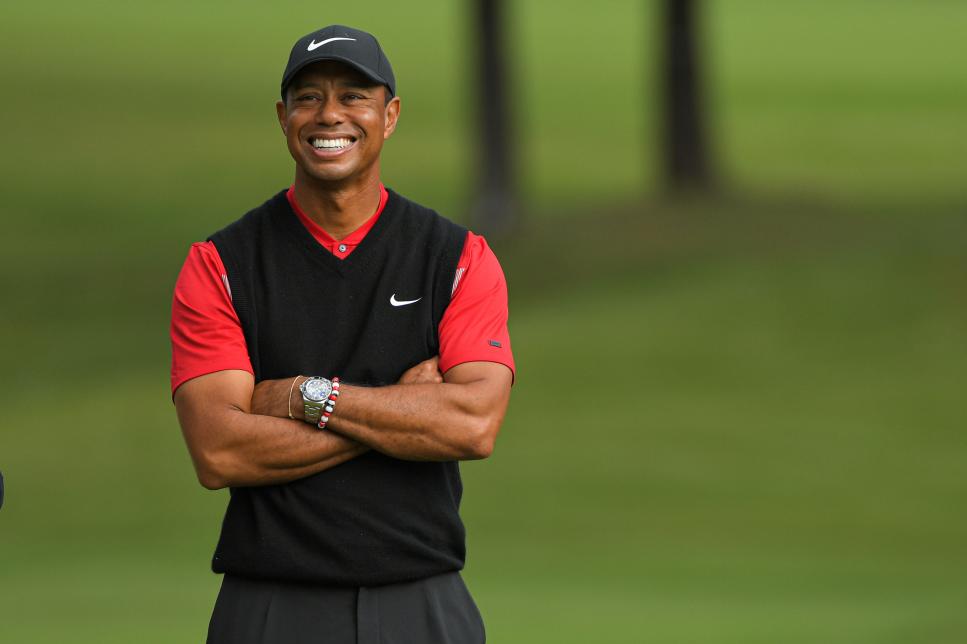
Ben Jared
No. 1: Tiger Woods
No two sporting comebacks are exactly alike. Some we see coming, others astound us. Some are sudden, others incremental. Some result in mere relevance, others in a triumphant return to the mountaintop.
And a green jacket.
One could argue that Tiger Woods’ comeback was complete before April 14, 2019. The first glimmer of hope, the first sign that he’d escaped the nadir of his adult life, actually came back December 2017, when he showed that a 41-year-old with a fused spine could swing a golf club 120 miles per hour. Three months later, he finished one shot out of a playoff in a full-field PGA Tour event. In the summer of 2018, he darn near won the Open Championship, then darner nearer won the PGA Championship. Last fall, he forced many pundits to eat their words by winning the Tour Championship.
No matter how far from the game he was, Woods never left the headlines—he was No. 15 on this list in 2016 despite playing zero PGA Tour events—but he was once again making them with his play, not his physical or his personal shortcomings.
Still, this is Tiger Woods we’re talking about. His standards are different. Or, at least, the standards applied to him are different. In an time when majors are more heavily emphasized than ever, and for a man whose career (for better or for worse) has always been measured by a quest to win 18 of them, winning a “normal” tournament was never going to be enough. He won eight of those across 2012-’13, and even returned to World No. 1, and few seem to remember or care much. Simply put: Tiger wouldn’t be really, truly, irrefutably back until he won another major.
Which brings us to the first tee at Augusta National Golf Club, 9:30 a.m. on Sunday, April 14. Woods had played his way into contention for the third major in a row. He started the final round two shots behind Francesco Molinari, who had looked physically incapable of making a bogey. Molinari held the tournament by the throat until he rinsed his tee shot on 12. Superstar-studded bedlam ensued—Brooks Koepka, Dustin Johnson, Xander Schauffele, Rickie Fowler, Patrick Cantlay, Jason Day, Tony Finau and Jon Rahm were all in with a shout.
So was Woods, who stayed patient as eagles and birdies and bogeys and double bogeys piled up around him. He birdied the par-5 13th and 15th to get his nose in front, and a high-draw 8-iron to three feet on 16 all but sealed the deal. A nervy bogey at the last was still good enough for a one-shot victory. It was the first time Woods had come from behind to win a major. A comeback to complete a comeback.
“It’s just unreal,” Woods said after his fifth Masters and 15th major pulled him within three of Jack’s 18.
Unreal, for sure. Also poetic. The signature image of 2019 in golf—and maybe sport in general—is that of Woods bear-hugging his son just off the 18th green, in virtually the same spot his father bear-hugged him after his first Masters, 22 years and umpteen surgeries ago.
Perhaps for the first time, Woods let himself bask in the glory of an accomplishment. That, coupled with a clandestine knee injury that eventually required surgery, led to a subpar summer on the golf course. After he missed the cut at the Open Championship at Royal Portrush, withdrew from the Northern Trust and failed to qualify for the Tour Championship, several pundits felt he shouldn’t pick himself for the Presidents Cup … with some going as far as wondering if the Masters was his swan song. People simply don’t learn.
He had the operation in August, and three months later he showed up in Japan swinging the club beautifully, opening with a pair of 64s and cruising to his 82nd PGA Tour victory, tying Sam Snead’s all-time record. He did, indeed, pick himself to play for the U.S. in Australia, and thank goodness for the Americans that he did—Woods went a perfect 3-0-0 in a virtuoso performance at Royal Melbourne, leading as captain and player as his side came back from a 9-5 deficit to win the Presidents Cup, 16-14.
“2019 has been incredible because I won a major championship again,” Woods said at the Hero World Challenge. “I tied Sam, and to come back from what I’ve come back from and have won three events, it’s been pretty good.”
“To have won a major championship again and to have my family there and my friends and everyone who’s close to me be there for that moment, there were times when we never thought that moment would ever happen again. But somehow it happened.”
After that transcendent scene at Augusta, 2019 in golf was always going to be remembered for Tiger Woods, just as 1986 is inextricably linked with Jack Nicklaus. For good measure, Woods finished the year with a sparkling run of play that virtually no one saw coming. As 2019 draws to a close, Woods isn’t just our Newsmaker of the Year—he might be the best golfer on the planet right now. Again. —Daniel Rapaport
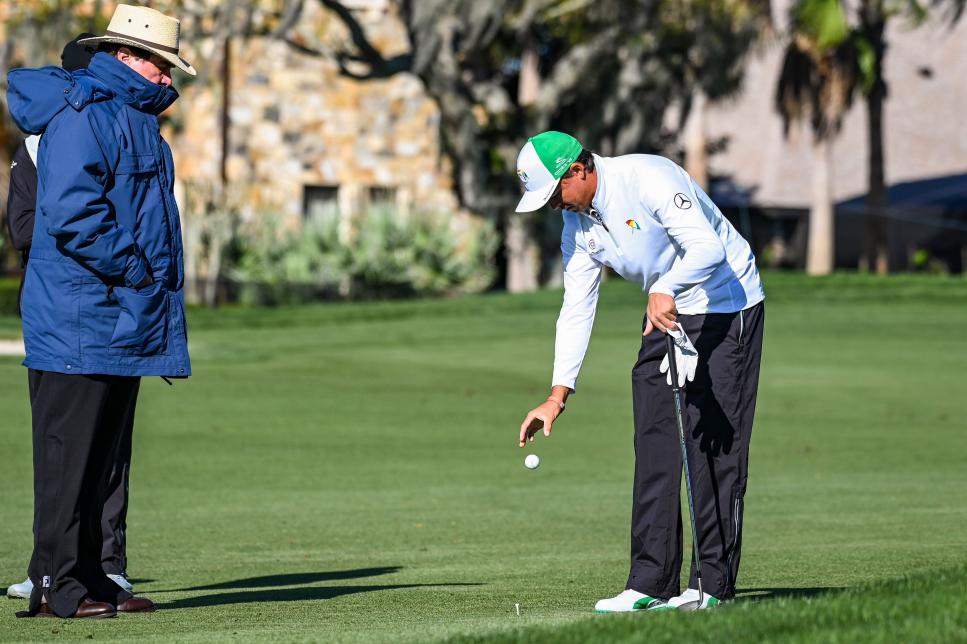
Keyur Khamar
No. 2: The new Rules of Golf
The new Rules of Golf went into effect with great anticipation—and some anxiousness—on Jan. 1, 2019. It was the most sweeping revision the USGA and R&A had made to the playing code in more than 60 years and required golfers at all levels to re-acclimate themselves to the game’s dos and don’ts. The hope from the governing bodies was that an update would reduce the confusion that the Rules can cause. But for the first few months of 2019, the change seemingly had the opposite effect, specifically at the professional level. During the final round of the Dubai Desert Classic, Haotong Li’s caddie was deemed to have stood behind the European Tour pro on the 18th green during the final round, thus violating the new rule regarding caddies and alignment. Two strokes were added to his score—it cost him a top-10 finish and roughly $100,000—but the interpretation of the rule caused some to speak out, including Euro Tour chief Keith Pelley, who called the ruling “grossly unfair.” Five days later, Denny McCarthy was hit with the same penalty at the Waste Management Phoenix Open. The PGA Tour took things a step further, announcing the next day that it had worked with the USGA and R&A on how to interpret the new rule and that an amendment had been made. But that wasn’t the only new rule that, once in effect and being used in competition, started to get stricter scrutiny. At the WGC-Mexico Championship, Rickie Fowler was hit with a stroke for an improper drop at the WGC-Mexico Championship when he forgot to drop from knee height instead of shoulder height. The next week at the Honda Classic, Alex Cejka was disqualified under the new rule limiting green-reading books. Beyond the violations themselves, it was the heated debate and troublesome discourse between players and the USGA and R&A that turned up the tension. Justin Thomas called the new Rules “terrible” and took to social media to call out what he felt were inequities the new Rules had created. In an act of defiance at the Honda, Fowler mocked the new drop rule by squatting and holding the ball from his posterior when faced with the situation again. Things reached a tipping point, though, when the USGA responded to Thomas’ criticism with accusations of him of canceling multiple meetings and the organization saying they “needed to talk.” Thomas retorted, saying the organization had never scheduled any meetings. That the USGA CEO Mike Davis touted the rollout as a “huge success” also struck some as odd. His R&A counterpart, Martin Slumbers, offered the more common thought, saying, “I think it’s fair to say that it hasn’t gone as smoothly as I would have liked.” As with most change, once tour pros became more familiar with their new environment, the outcry dissipated. Golfers running afoul with the Rules will never go away (See Patrick Reed/Hero World Challenge), but the acrimony has subsided. —Brian Wacker
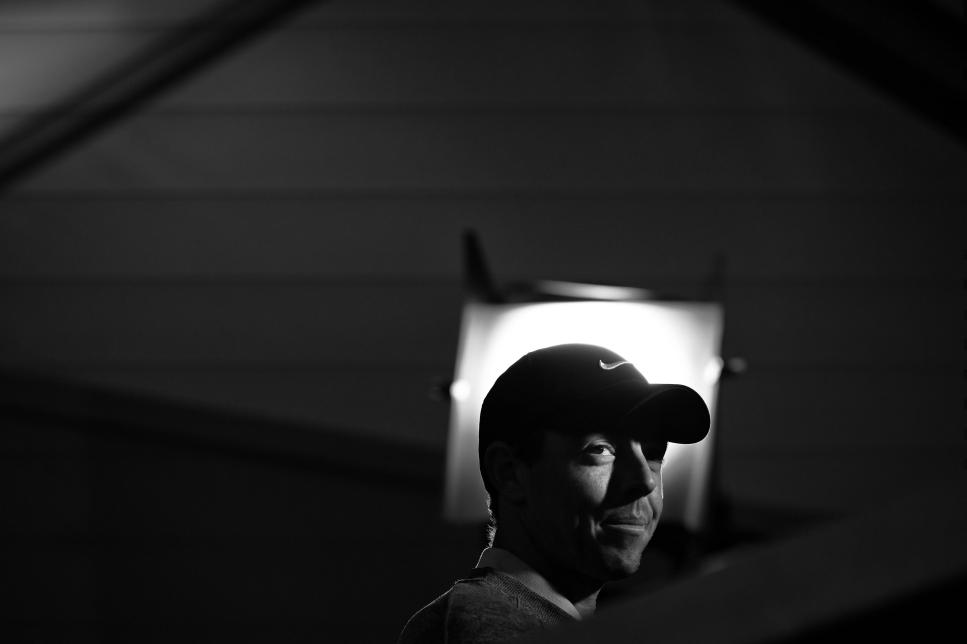
Charles McQuillan/R&A
No. 3: Rory McIlroy
Few players’ stories in 2019 are as dynamic and transitional as the narrative of Rory McIlroy. The Ulsterman began the season under much derision. Sunday stumbles at the Sentry Tournament of Champions and Arnold Palmer Invitational—coupled with a handful of high-profile failings in 2018—led to the charge that McIlroy had become a poor crunch-time player. That stigma was seemingly quelled with a breakthrough win at the Players Championship in March, McIlroy defeating the sport’s toughest field on its most fickle course. Two more wins during the summer, at the RBC Canadian Open (with a Sunday 61) and the season-ending Tour Championship, should have strengthened his standing. But McIlroy has reached the rarified stature where one is not judged by wins but majors, and majors only, and in that realm Rory came up short. He was never in contention at the Masters, the one he needs to finish the career Grand Slam, or the PGA Championship, and fell off the weekend leader board following a strong start at the U.S. Open. At the Open Championship in McIlroy’s native Northern Ireland, the 30-year-old opened with a 79, a score that conjured those pressure-performance questions. McIlroy responded with a valiant Friday run at Royal Portrush, but ultimately missed the cut, giving McIlroy his fifth consecutive season without a major win. As unfair as the four-tournament barometer may be, McIlroy’s 2019 was still one of success. He did win the FedEx Cup title for the second time in his career and, somewhat controversially, the PGA Tour’s Player of the Year award, and had the highest all-time strokes gained output of a player not named Tiger Woods. In 25 worldwide starts, he had 19 top-10 finishes (and one missed cut). Moreover, McIlroy continued a curious, and enthralling, showdown with the European Tour brass over his Old World status, and his reign as the most cerebral and transparent player behind the mic endures. McIlroy added a fourth win in the fall at the WGC-HSBC Champions, and finishes the year as the No. 2 player in the world. The man ahead of him, Brooks Koepka, has brushed aside rivalry notions, noting McIlroy has failed to win a major since Koepka has captured his four. Koepka is right, but also right in a different fashion. When it comes to compelling studies, McIlroy and his journey are peerless. —Joel Beall
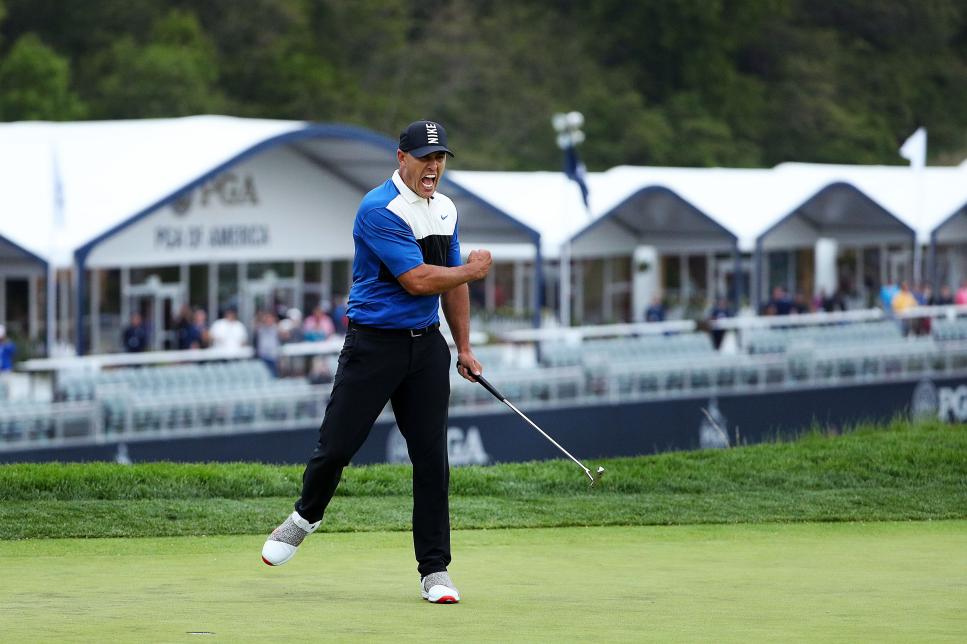
Patrick Smith
No. 4: Brooks Koepka
Out with an injured left knee since October, Brooks Koepka’s year ended quietly. All we can say about that is, well, he was due. Until the World No. 1 fell short at the Tour Championship in August to Rory McIlroy, Koepka made noise in a myriad of ways in 2019. Of course, the most resounding was on the golf course, where he proved to be a boss in the majors once again, repeating in the PGA Championship and finishing second in the Masters and U.S. Open. Koepka’s performance in the PGA at Bethpage Black was stunningly brutish. He opened with a seven-under 63 playing alongside Tiger Woods and went wire-to-wire to join Woods as the only players to repeat in the championship since it went to stroke play in 1958. That made four major wins in his last eight tries for the 29-year-old Florida native, joining Jack Nicklaus, Ben Hogan and Woods as the only players in the modern era to win that many that quickly. Koepka also became just the fourth man to successfully defend a major championship title more than once. The others: Woods, Bobby Jones and Walter Hagen. Koepka even impressed in defeat. In the U.S. Open at Pebble Beach, Gary Woodland bested him, but Koepka became the first golfer in championship history to lose despite shooting four rounds in the 60s. In all, Koepka won three times during the tour’s wraparound season and captured the PGA of America’s Player of the Year title. But, in a bit of a controversial development, McIlroy, the FedEx Cup champion, was voted PGA Tour Player of the Year. It marked just the third time the honors were split. But if you thought a rivalry was brewing between them, you’d be mistaken, at least according to Koepka, who dismissed that notion at the CJ Cup in South Korea. “I’ve been out here for, what, five years? Rory hasn’t won a major since I’ve been on the PGA Tour. So, I just don’t view it as a rivalry,” he said. Koepka’s candor proved as relentless as his golf. He was outspoken on the subject of slow play (famously discussing the subject with Bryson DeChambeau on the range at the Northern Trust) and had some choice words (and tweets) for Golf Channel’s Brandel Chamblee, who questioned his decision to drop more than 20 pounds for his bare-all photo shoot in ESPN The Magazine’s Body Issue. Koepka’s year ended prematurely after two rounds at the CJ Cup when he re-aggravated the knee that had required treatment after the Tour Championship. He withdrew from the Presidents Cup and hasn’t offered any hints on when he might return. Here’s hoping it’s relatively soon. It’s gets kind of quiet when Koepka’s not around. —Dave Shedloski
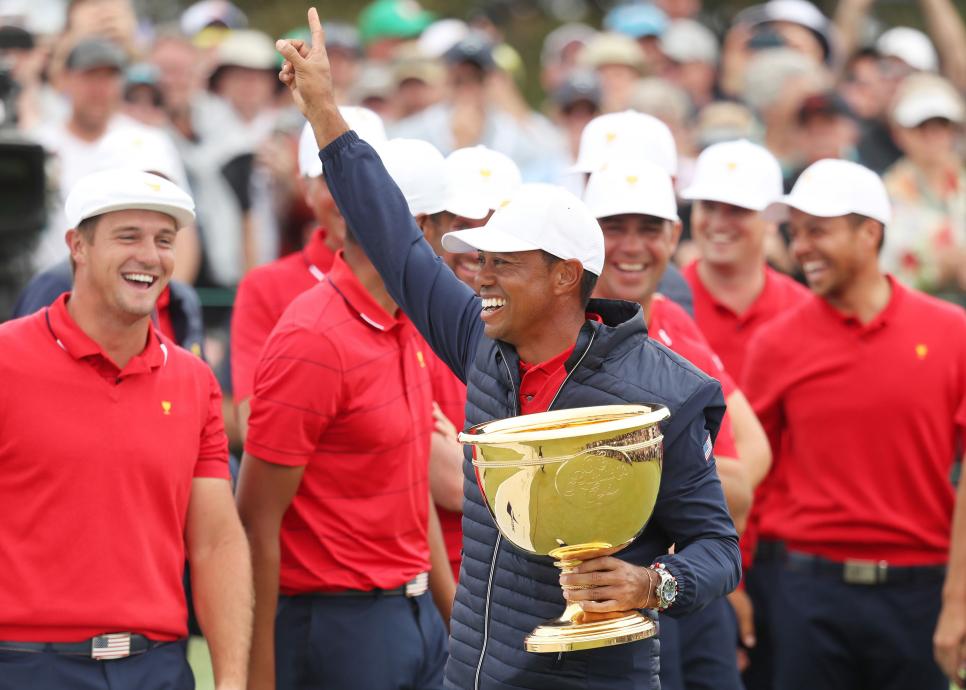
Rob Carr
No. 5: Presidents Cup
To call the 2019 Presidents Cup an instant classic risks a bit of recency bias, the grandstands surrounding Royal Melbourne not yet fully dismantled after Sunday’s entertaining finish. But the legacy of last week’s showdown in Australia—with the Americans wearing out the Internationals in singles on the last day to eke out a 16-14 comeback victory—is not likely to lose significance over time. It had major champs stepping up (Tiger Woods, Adam Scott, Louis Oosthuizen), underdogs underdogging (Cameron Smith, Abraham Ancer) and an outcome in doubt with just three matches left. It had viral moments (Tiger’s and Justin Thomas’ “I love me some me” celebration), player intrigue (Haotong Li’s benching) and captain gamesmanship (Ernie Els’ insisting that the passionate home fans weren’t crossing any lines) that will be forever linked to the week Down Under. Oh, and it had the messiest mess you could imagine in Patrick Reed and the aftermath of his Hero World Challenge rules violation. (You know it all by now: vocal crowds, an obdurate player and a caddie literally tossing himself in between.) Give credit to Els, in the first of what will hopefully be many stints as the Internationals’ captain, for passionately trying to create a cohesive team, adopting an analytical approach to pairings and course management that all but took the Internationals to the finish line. Els’ hands-on involvement—it felt like the four-time major champion cloned himself, the way he appeared to be following every match on the course—deserved more than a moral victory. In turn, for as good as Woods was as a player—3-0, more than justifying the captain’s pick he gave himself to make the 12-man team—Tiger handled his maiden stint as the team’s leader with confidence. Woods went more with his gut than numbers, even when it meant benching himself, but the strategy of trusting his guys (even Reed in singles) paid off. Pessimists will likely wonder about the Internationals’ chances of stopping the Americans’ streak of Cup wins (eight and counting) under these favorable circumstances, the Americans missing the World No. 1 player, still jetlagged at the start of play and juggling the mother of all distractions. If not now, when will they ever win the Cup back? We’d like to see the silver linings: Sungjae Im, 3-1-1 as a rookie, and Joaquin Niemann are both 21, Smith is 26 and Ancer is 28. Els seems invested in the future, and maybe even more motivated to stop the streak under his watch. What four days at Royal Melbourne showed is that there lives the potential for a meaningful rivalry, which could be the 2019 Presidents Cup’s greatest impact. —Ryan Herrington
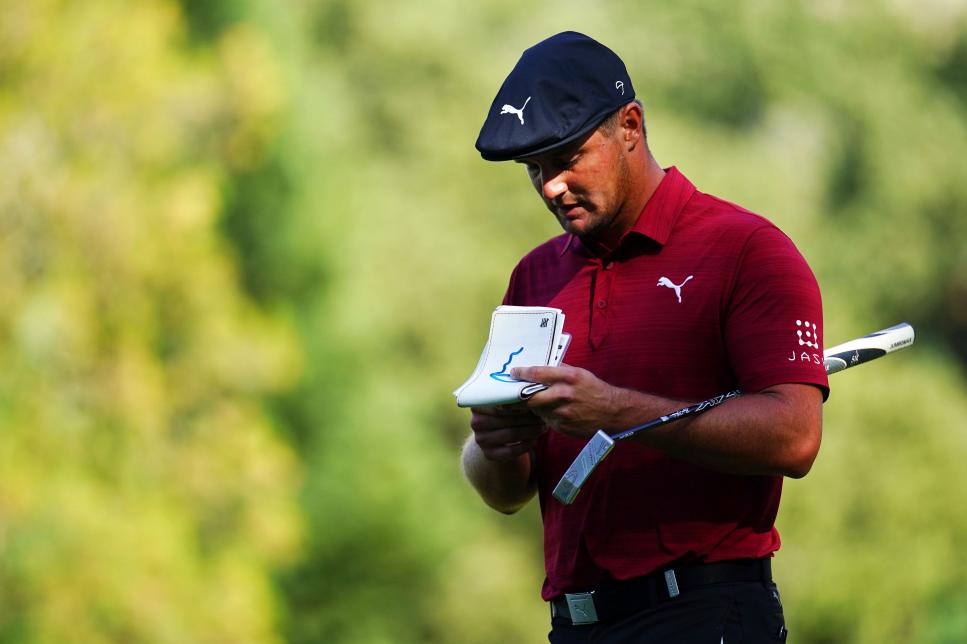
Daniel Shirey
No. 6: Slow play
After slow-playing the issue (pun intended) of slow play for decades, the world’s two major golf tours passed initiatives in 2019 designed to address a problem that unfailingly had continued to go from bad to worse. After much conversation arose during J.B. Holmes’ pedantic, but victorious, final round at the Genesis Open in February, the tipping point seemed to arise in August as a not-so-august conversation ensued on Twitter and elsewhere after Bryson DeChambeau was called out for his, um, methodical pre-shot deliberations at the Northern Trust at Liberty National in New Jersey. Criticism was sharp. English golfer Eddie Pepperell admonished DeChambeau for his actions, calling him an “unaffected, single-minded twit.” (He later apologized.) In response to the growing cacophony, DeChambeau demurred and denounced, and then he unwisely dragged the caddies into the conversation as abettors, if not outright offenders. (Oof.) Two weeks later, the European Tour released a four-point plan to address the issue, focusing on regulation, education, innovation and field sizes. Key changes, set to begin in January, include the levying of penalty shots and increased fines for habitual laggards. Euro chief Keith Pelley might have had some incentive to act after Edoardo Molinari tweeted his displeasure with slow play and promised to release the tour’s list of slow-play offenders. A day later, he did. In November, the PGA Tour’s policy board passed its own set of measures. First reported Nov. 22 by Golf Digest, the revamped pace-of-play guidelines are expected to include the creation of a list of players who repeatedly breach a 45-second time limit to execute a shot, which would expose them to potential penalty strokes for further breaches. The PGA Tour is likely to institute its measures in April at the RBC Heritage following a three-month education period. “I like what they’re doing,” Phil Mickelson said. “I like that they holding the individual accountable, and I like that they’re not stressing trying to speed things up on Thursday-Friday when that just isn’t going to happen with so many people on the golf course.” A few players mentioned being uncomfortable with a list, but understood the goal of trying to hold individuals responsible compared to hitting an entire group with a bad time for undue delays. Whether these measures make a difference will play out over time, and further tweaks undoubtedly will be necessary. But as one player noted, “We have to start somewhere. We’ve been talking about this long enough.” Yeah, decades. —Dave Shedloski
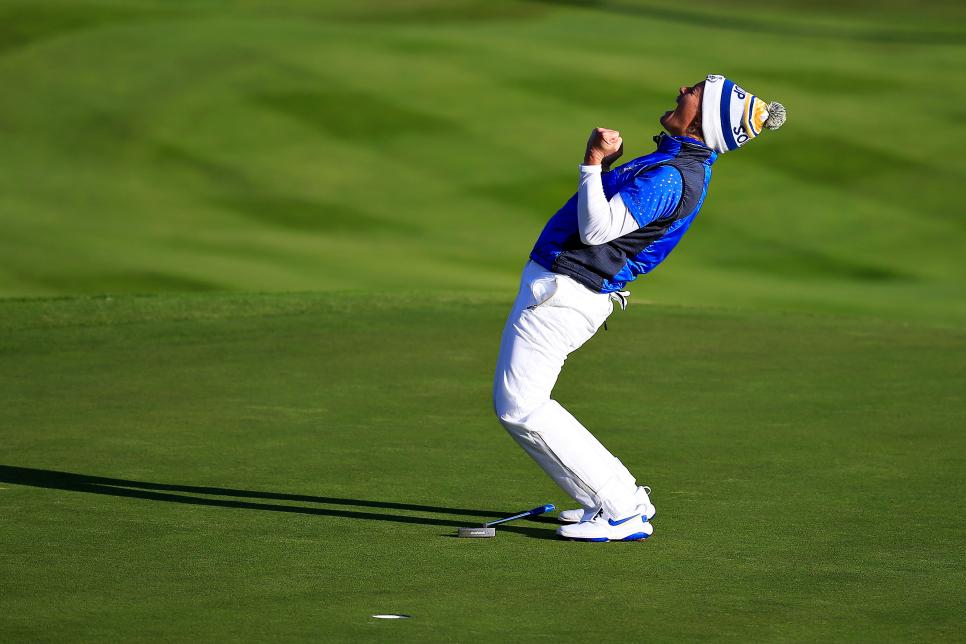
Chris Trotman/WME IMG
No. 7: Solheim Cup
When Catriona Matthew took Suzann Pettersen, the No. 620 player in the world, with one of her captain’s picks for the 2019 European Solheim Cup team, critics decried the choice. Despite eight previous Solheim Cup starts, Pettersen, 38, had been away from the game for nearly two years for maternity leave and had played in just two events prior to arriving at Gleneagles in September. But Matthew’s choice went from crazy to genius when Pettersen holed the winning putt for the home side on the 18th green on Sunday to clinch Europe’s first victory in the biennial event since 2013. It wasn’t just the Hollywood style ending that no one saw coming, but the ultimate result, too. Team USA, captained for the third time by Juli Inkster, was listed as 2-1 favorites entering the matches, only to have things start to get complicated once the Americans crossed the Atlantic. Angel Yin’s golf bag was lost by an airline and barely got to Scotland in time for play. Stacy Lewis was forced to withdraw at the last minute with an injury, her replacement Ally McDonald becoming the sixth rookie in the U.S. lineup. And Danielle Kang’s intent at humorous hyperbole (“you're trying to take souls,” “just crush the other team”) became misconstrued as trash talking. When the competition began, there were bright spots on both sides: Americans Jessica and Nelly Korda became the first sisters to be paired together in Solheim Cup history and thrived, winning twice by decisive margins. For Europe, Celine Boutier, a Solheim rookie, and Georgia Hall, won each of the four matches they played. Tied 8-8 entering singles, things remained tense throughout a memorable Sunday. With 10 matches completed, the U.S. clung to a one-point lead, Europe’s Bronte Law 1-up on McDonald thru 16 holes and Pettersen and Alex tied as they walked up to their birdie putts on the 18th. Then came the mad sequence of events: Alex missed on 18, and Law made birdie on 17 to close out McDonald. Pettersen’s six-footer now was to win the Cup outright, 14½-13½. When it fell—was there ever a doubt that it would?—Pettersen was engulfed in a crowd of teammates, caddies and fans. The moment became even more memorable when Pettersen revealed she was retiring from competitive golf. “I think this is a perfect closure,” Pettersen said. “A nice ‘the end’ for [my] professional career. It doesn’t get any better.” No argument here. —Keely Levins
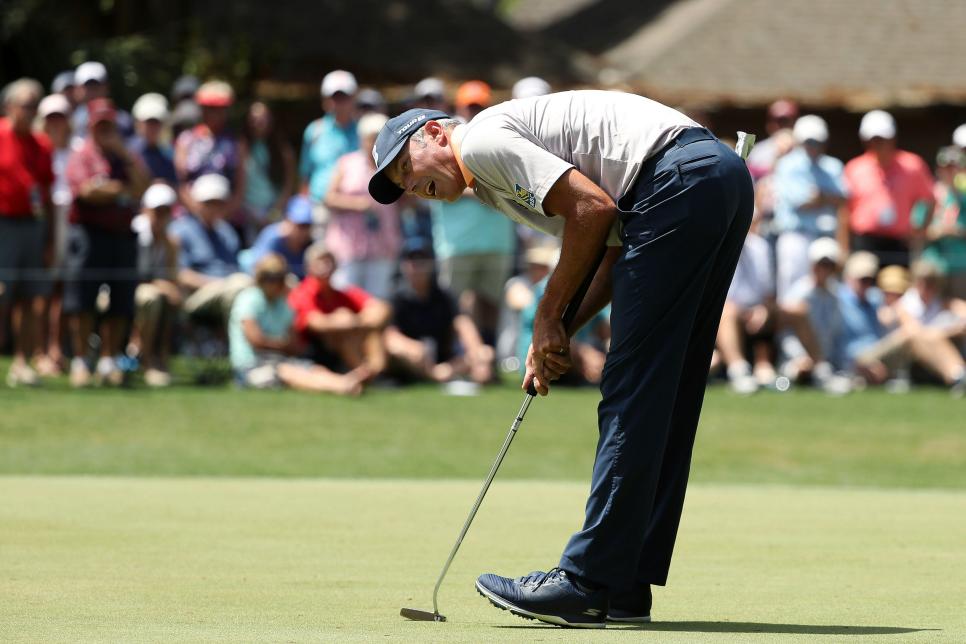
Streeter Lecka/PGA Tour
No. 8: Matt Kuchar
Matt Kuchar must have mixed feelings about 2019. The good: a ninth PGA Tour victory, two runner-up finishes and clinching the winning half-point for the U.S. at the Presidents Cup in his fifth appearance in the biennial event. The less good: dirtying a previously spotless reputation. It started back in November 2018, when Kooch used local caddie David (El Tucan) Ortiz at the Mayakoba Classic. The two agreed, according to Kuchar, that Ortiz would get $5,000 for the week. Kuchar went on to win and made $1.3 million for his efforts. Standard procedure calls for a player to pay his caddie roughly 10 percent of a winner’s check, but Kuchar decided against giving Ortiz any bonus at all, meaning he paid his looper less than 0.4 percent of his winnings. The public didn’t learn about this until January, when Kuchar was contending at the Sony Open (which he also won). After initially defending his actions, Kuchar eventually apologized … and paid out another $45,000. But his strangely scandalous year was far from over. At the WGC-Dell Match Play, Kuchar again found himself at the center of a controversy when he didn’t verbally give Sergio Garcia a two-inch putt that Garcia missed. Kuchar told a rules official that he didn’t say “it’s good,” meaning Garcia lost the hole. As you might imagine, Garcia was not pleased. A few days later, the two put out a truly odd video trying to put the awkward situation behind them in its own awkward way. For good measure, Kooch had another snafu at the Memorial, when he pleaded for a dubious drop in the fairway. TV footage showed he didn’t deserve the drop, and two rules officials told him as much. Unconvinced, he asked if he could seek a third opinion. The answer was no. The outrage from the match-play mixup and the Memorial imbroglio should fade with time. Unfortunately for Kuchar, no one will forget El Tucan. —Daniel Rapaport

NBC
No. 9: Amy Bockerstette
It began as a nice gesture. It transformed into a phenomenon. Tournament officials at the Waste Management Phoenix Open invited then-20-year-old Amy Bockerstette—a Special Olympian and Paradise Valley Community College athlete with Down Syndrome—to play a practice-round hole with Gary Woodland, at the event’s famed (perhaps “notorious”) par-3 16th. In one of the more pressure-packed environments the sport has to offer, Amy made a marvelous up-and-down out of a bunker to save par, delighting thousands camped in the grandstands, a feat, in itself, that was remarkable. Injected with Bockerstette’s confidence and nerve, and wrapped in Woodland’s joy and admiration, the moment became so much more. The clip of Amy’s triumph racked up 43 million social-media visits, becoming the most-watched PGA Tour video of all time. “I’ve had a lot of good memories in my life, but that’s one I’ll never forget,” Woodland said. “I've been blessed to do lot of cool things on the golf course, but that is by far the coolest thing I’ve ever experienced.” That Woodland would go on to win the U.S. Open that summer, and cite Amy as an inspiration, seemed to be the perfect ending to this tale. Only Bockerstette wasn’t ready to go away. She traveled the country as a spokesperson for special-needs athletes, giving a part of society that’s often overlooked a voice. She served as the keynote speaker for the National Down Syndrome Congress Annual Convention and received a standing ovation for her speech, “What’s Your Superpower?” And in the fall, on her 21st birthday, Amy launched the “I Got This” Foundation, its mission to promote golf instruction and playing opportunities for people with intellectual disabilities. “She has this special something that just radiates,” says her father, Joe. “She was put on this earth to do good.” Amy Bockerstette “went viral” in 2019. But her story is just getting started. —Joel Beall

Getty Images (3)
No. 10: Matthew Wolff/Viktor Hovland/Collin Morikawa
Every some-odd years, a group of tantalizing young players emerges seemingly all at once. The high school Class of 2011 comes to mind: Jordan Spieth, Justin Thomas, Xander Schauffele and unofficial member Bryson DeChambeau, who graduated in 2012 but is born in the same six-month span as the other three. Those guys are all now 26, seasoned veterans by today’s standards. Golf was ready for a wave of newer, younger players to provide the sport a jolt and give it a peek at its future. Enter 2019’s next wave: Matthew Wolff, Viktor Hovland and Collin Morikawa. Unlike their elders, there’s a bit of an age disparity within this trio. Morikawa (born February 1997) will be 23 before Wolff (April ’99) has his first legal drink, and Hovland was a year ahead of Wolff at Oklahoma State, while Morikawa, a Cal-Berkeley grad, was the member of the trio to play four years of college ball. But all three are linked, because each turned pro in June 2019 after sparkling amateur careers—Morikawa reached World No. 1, Hovland won the 2018 U.S. Amateur and Wolff won the 2019 NCAA individual title—and because each enjoyed immediate success on the PGA Tour. Wolff, whose unique and explosive swing has made him a social-media sensation, won in just his third start as a professional when he eagled the 72nd hole at the 3M Open for a one-shot victory over … Morikawa. Four weeks later, Morikawa picked up his first victory at the Barracuda Championship. Hovland is the only one without a win, but he’s put together a highly impressive resume of his own, setting a PGA Tour Shotlink-era record with 19 consecutive rounds in the 60s. Anyone searching for evidence that today’s youngsters are ready to win immediately need only look at these three. —Daniel Rapaport

Mike Ehrmann
No. 11: Shane Lowry
His was a victory that touched and united a sadly often fractured island. And a victory for an increasingly over-matched art over science. Shane Lowry, “champion golfer of the year” at Royal Portrush, brought tears to eyes, smiles to faces and momentarily at least restored shot-making to a modern game where creativity is so often an elusive quality. Indeed, a nation celebrated. Even before the final putt was made, Lowry’s family, friends and compatriots gathered to witness his finest moment. Behind the 18th green stood former U.S. Open champion Graeme McDowell, European Ryder Cup captain Padraig Harrington, local man Ricky Elliott (Brooks Koepka’s caddie) and Scotsman Neil Manchip, Lowry’s swing coach. All bonded by their obvious affection for the man about to banish some long-standing demons. “All of those people have been the ones who have had the biggest influences on my career,” said Lowry, whose epic chipping contests with Harrington are an endlessly inventive, must-see part of European Tour practice days. “That was really cool, to have them all there.” It was, in short, the ultimate feel-good win for the Irishman who arrived in Portrush an un-fancied outsider. Which was understandable. For all his experience of links golf, Lowry had missed the cut in his four previous appearances at the Open Championship. Perhaps more damningly, ever since a four-shot 54-hole lead in the 2016 U.S. Open at Oakmont evaporated, he was also a man accused of under-achievement. No matter. Displaying a verve and style of play only enhanced by his likeable demeanor, Lowry beat the world’s best with an endearing display of “old-fashioned” golf. In some typically tough Irish weather, the 32-year-old’s imagination and flair cheered those increasingly disenchanted by the sameness that is often a part of modern professional golf. The aftermath was just as eventful. In typical Irish style, Lowry celebrated what he would later label “the first paragraph of my obituary.” Pint of Guinness in hand, pictures of him singing “the fields of Athenry” in a Dublin pub hours after holing-out on that 18th green went round the world. “Everyone had a drink out of the claret jug,” he told Golf Digest. “We didn’t get to the bar until about 1:30 a.m. And we were there until about 7 a.m. I actually enjoyed the last couple of hours most of all. The people closest to me were there then. All the hangers-on had fizzled out and gone home. We got a taxi home—it’s only 15 minutes as we live almost in the city—and went to bed. I woke up maybe two hours later. And there was the jug sitting there on my bedside locker.” —John Huggan
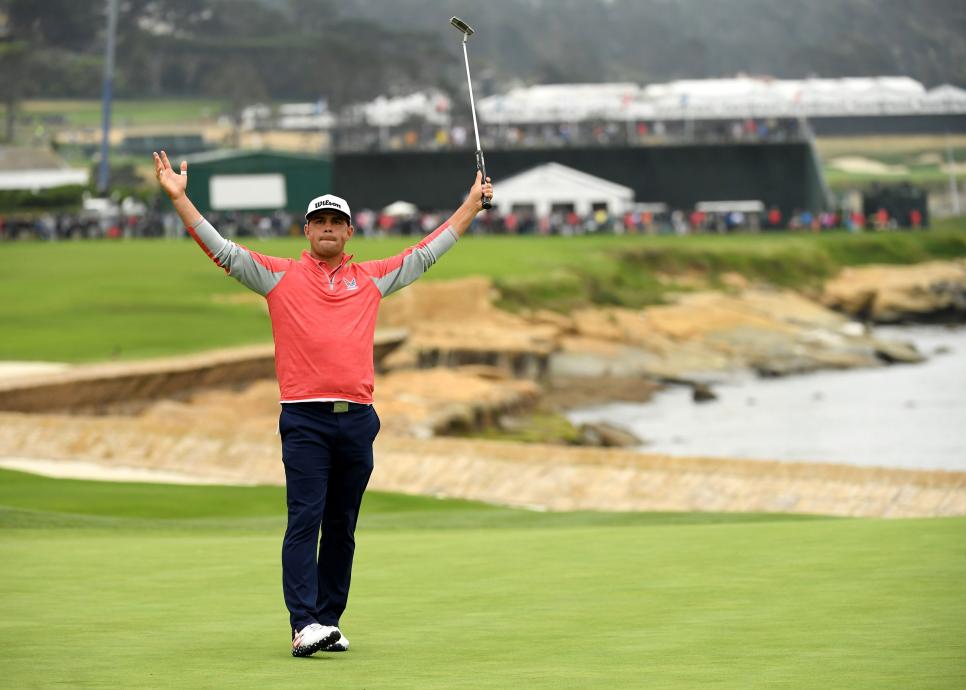
Ross Kinnaird
No. 12: Controversy-free U.S. Open
The USGA arrived at Pebble Beach in June with little margin for error, thanks to three self-inflicted controversies in four previous U.S. Opens. Its snafu at Shinnecock Hills in 2018 was especially alarming, as the governing body repeated a mistake it said it never would. Another faux pas, this time on the Monterey Peninsula at the nation’s preeminent public course, could have been cataclysmic. Feeling the pressure, the organization answered, and did so with vigor. USGA CEO Mike Davis passed responsibility for the course set-up to John Bodenhamer, the senior managing director of championships. Bodenhamer preached discipline from his side, to let the course speak for itself. And, thankfully, it did. Pebble’s rough was gnarly but fair, there were no goofy pins, and the greens weren’t menaced by an impromptu buzzcut. Perhaps it sounds like a rudimentary game plan, but it was one Bodenhamer admitted the USGA had, inadvertently or not, departed from. Not shy in the past to air their grievances, the players were effusive in their praise. Even Phil Mickelson, who has treated the USGA with the disdain of a vegetarian at McDonalds, was complimentary, calling Bodenhamer’s Pebble presentation “a hard test” that was “perfectly done.” The only real knock was the course was too easy: In the four previous Opens at Pebble, a total of 12 players were under par compared to 31 this summer, and winner Gary Woodland finished with the the second-lowest score in U.S. Open history at 271. Conversely, erring on the side of caution is what the week called for. One tournament does not erase multiple mishaps, but when the USGA desperately needed to stay out of its own way, Bodenhamer kept the spotlight, rightfully, on the field. —Joel Beall
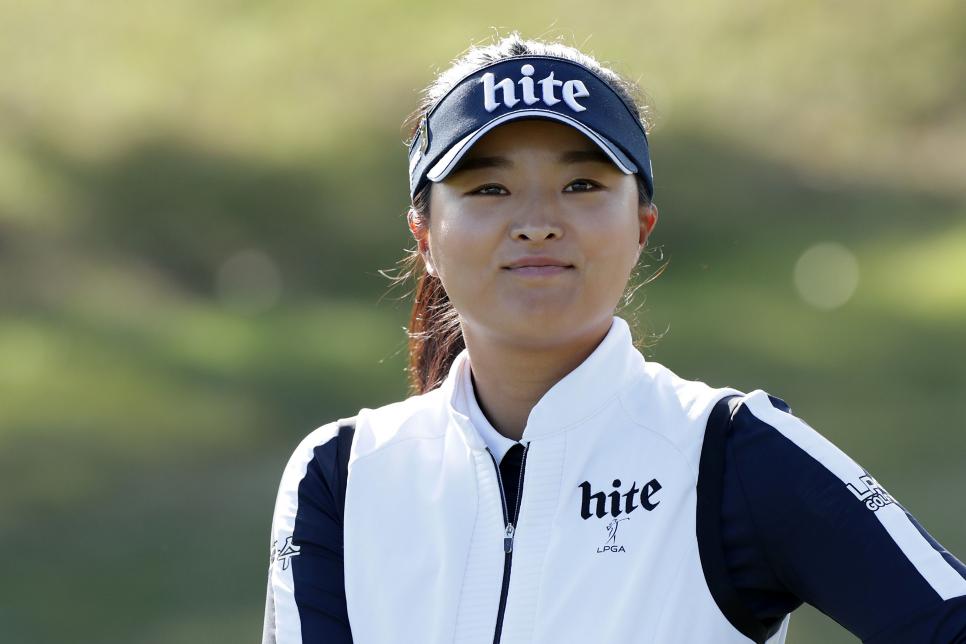
Han Myung-Gu
No. 13: Jin Young Ko
The depth of talent on the LPGA Tour, where 23 players from nine countries won titles in 2019, makes it hard to stand out from the crowd. But there’s little doubt who was the tour’s most-dominant golfer. Jin Young Ko, building off her rookie-of-the-year season in 2018, topped essentially every meaningful metric this season. In 22 starts, she had 12 top-10 finishes, including four victories, the most of any player. Two of those wins were majors, the ANA Inspiration and the Evian Championship. She hit 79.56 percent of greens in regulation. She had 47 rounds in the 60s, the most on tour, which contributed to her 69.06 scoring average, second-best in tour history behind Annika Sorenstam’s 68.697 in 2002. Ko even broke one of Tiger Woods’ records: she went 114 consecutive tournament holes without a bogey (Tiger’s mark was 110). Ko, 24, said one of the keys to her success this year was the work she’s done with a sports psychologist back in South Korea. Early in her career, Ko struggled with demanding perfection from herself, but has come to appreciate how that’s not a reasonable goal. Instead, the World No. 1 and LPGA Tour player of the year, focused on being happier on the golf course and in her personal life, and given how many smiles we saw from her on the course, she seems to be found the proper balance. “Bogey is fine,” Ko said at the Evian Championship, where she managed herself beautifully through a tumultuous stretch where she went birdie-bogey-birdie-bogey-birdie … and eventually trophy. “I’m not a robot. I’m human.” It’s ironic, in releasing the pressure she’d been putting on herself to be perfect, she got even closer to perfection. —Keely Levins
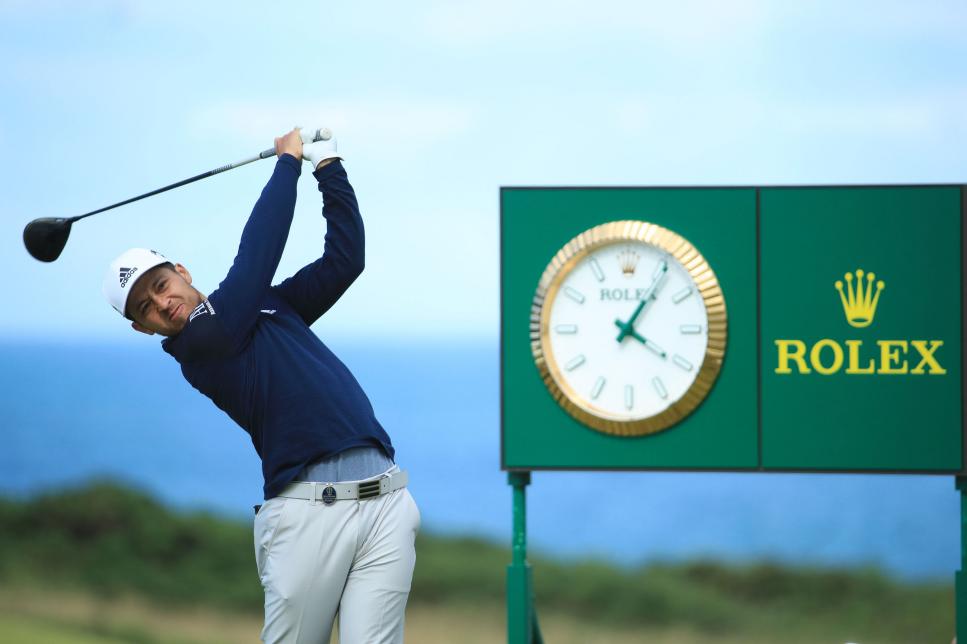
Andrew Redington/Getty Images
No. 14: Driver Testing
Drivers—and some of the tour players who use them—got smacked around in 2019, and not just at impact off the tee. At the Open Championship at Royal Portrush in July, a handful of the 30 randomly selected clubs failed the USGA and R&A’s test for spring-like effect, most notably the driver of Xander Schauffele (above). When news of this came out, it created more questions than answers. Were players intentionally trying to use hot drivers? How big a problem was it? And how do you prevent this from happening again? The answer to the former is an unequivocal absolutely not. The test equates to a speed limit for drivers, but driving slightly over the limit increases distance only a matter of feet, not yards—if that much. And manufacturers have been giving drivers to players that test in the “tolerance zone” for years. The problem, however, is that players can use a driver that passes initial tests but through use over time, the face can get hotter. (There is also a variance in the machines used for the test.) As such, some clubs can go over the limit and become non-conforming without the player being aware. This issue, while not egregious, was enough to warrant concern. In September, the PGA Tour sent a note to its members announcing an enhanced driver-testing protocol for its events, including mandatory testing of players’ drivers when selected, similar to the tour’s drug-testing policy. A few weeks later at the Safeway Open, multiple drivers tested were found to be nonconforming. The expectation moving forward is that players will work with their respective manufacturers to ensure the drivers they receivehave little-to-no chance of going over the limit, even after use. The reward of an extra foot of distance does not outweigh the risk of having a driver yanked out of a bag a day or two before a tournament starts. Although most players welcome the testing to ensure conformance, some, including Schauffele, would like to see the tour go even further. “What’s the fair thing to do?,” Schauffele posed at Portrush. “You test everyone, it’s simple as that.” While the tour isn’t quite there yet, the new protocol appears to be a positive step in assuring that drivers in play on the PGA Tour only get smacked around when they hit a ball—and not in a testing room. —E. Michael Johnson

Kevin C. Cox/Getty Images
No. 15: Augusta National Women’s Amateur
What exactly were we anticipating from the inaugural Augusta National Women’s Amateur? It’s a tricky question to answer now in hindsight, the joyful memories from eight months ago coloring any preconceived visions of what we thought might come to pass. Club chairman Fred Ridley had high hopes upon announcing the creation of the tournament in April 2018, and he probably would have deemed it a success no matter what happened in Year 1. Yet, as often is the case at the old Fruitland Nurseries, reality topped expectations, 3 and 2. Any awkwardness that came with playing the event the same week as the year’s first LPGA major, or having the tournament pause after 36 holes at Champions Retreat (to allow all competitors, including those not making the 36-hole cut, to get a practice round in at Augusta National) was offset by how things played out when the competition resumed for the final round. It was all brand new—a women’s competition on the famed course—yet it all felt natural, from the foursome of Nancy Lopez, Annika Sorenstam, Se Ri Pak and Lorena Ochoa hitting opening tee shots, to eventual champion Jennifer Kupcho making a 20-foot birdie on the 18th to beat Maria Fassi by four shots. No, this wasn’t the Masters, but the atmosphere was vintage Augusta National. When Kupcho holed an eagle putt on the par-5 13th, the roar could be heard back up to the clubhouse. The Wake Forest senior, who deferred her LPGA Tour card earned the previous December in part to compete in the event, played the final six holes in five under par. Yet even she knew it wasn’t winning that necessarily mattered, but the chance to set a goal for other females. “I really think we’re going to start something great in women’s golf,” said Kupcho, 22, of the potential long-term legacy of the ANWA. “It’s been an experience of a lifetime and I’m glad I have it.” —Ryan Herrington
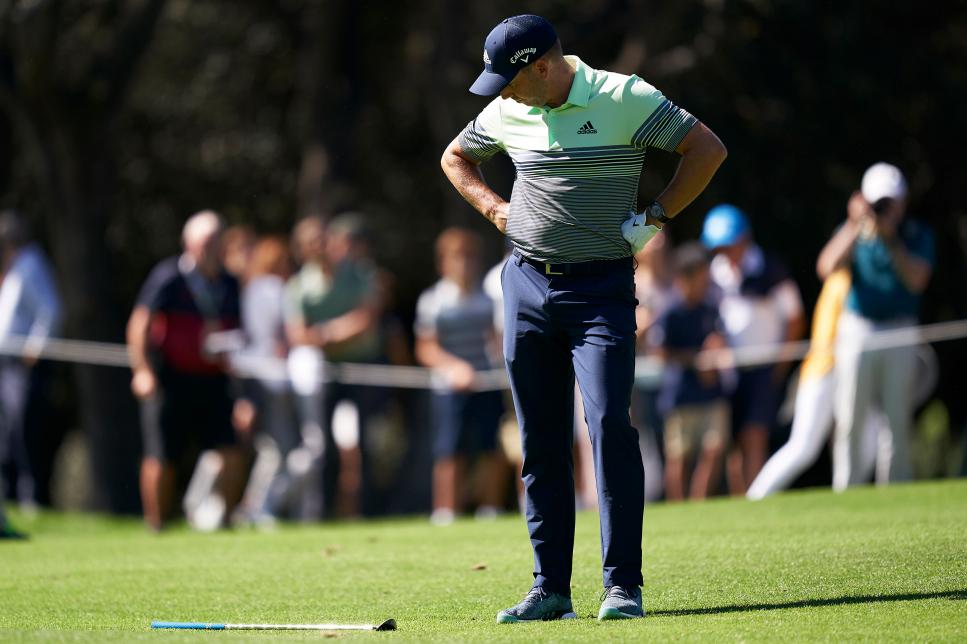
Quality Sport Images
No. 16: Sergio Garcia
On Feb. 2, Sergio Garcia was disqualified from the European Tour’s Saudi International for “serious misconduct” after intentionally damaging five greens at Royal Greens Golf & Country Club. Video also surfaced of him throwing a temper tantrum in a bunker, Garcia taking several angry swipes at the sand after hitting a shot. In the aftermath, he apologized and informed his fellow players such an egregious act would never happen again. Ten days later, he offered more contrition on Instagram, saying “What happened is not an example I want to set, and it's not who I truly am.” Except time and again Garcia, 39, proved otherwise in 2019. In July, video showed Garcia throwing his driver at his caddie after an errant tee shot during the final round of the Open Championship at Portrush. At the WGC-FedEx St. Jude Invitational a week later, Garcia took out his frustrations on a tee box with another angry swing, this one taking a huge divot after a wayward shot. Petulance took other forms, too. At the WGC-Dell Match Play at the end of March, the 2017 Masters champ was facing Matt Kuchar in the quarterfinals. After missing a seven-footer for par on the seventh hole at Austin Country Club, Garcia, without looking up, backhanded his next putt from a few inches back toward the hole, the ball lipping out. Kuchar, on the back of the green and more than 30 feet away, never told Garcia the putt was good. The two men met with the rules official walking with their group, Garcia admitted being in the wrong, and Kuchar won the hole. Inexplicably, Garcia then suggested to Kuchar, who said he didn’t want that to be how a hole was won, that he could concede the next hole. Kuchar rightfully didn’t like that idea and eventually went on to win the match. They later made an awkward video on social media with an explanation that amounted to everything being “all good” between the two. For Garcia, though, it was yet another apology in a year that seemed to leave little doubt as to who and what he really was. —Brian Wacker

Gerardo Mora/Getty Images
No. 17: Hank Haney
We’d love to tell you that the story of the 2019 U.S. Women’s Open was its winner, South Korea’s Jeongeun Lee6. Or focus on how the host course, the Country Club of Charleston, a fantastic, firm and fast Seth Raynor design, made for an exciting and dramatic finish. Unfortunately, the week’s headlines were stolen by Hank Haney, who mockingly predicted on his Sirius XM radio show that “a Korean” would win, specifically a Korean with the last name Lee, prior to the championship. Not surprisingly, Haney’s comments spread quickly via social media, with a majority of golf fans and media pointing out how offensive they were. Several notable players joined the conversation, Michelle Wie, Brittany Lincicome, Karrie Webb, and Annika Sorenstam, among others, chastising the famed instructor for his verbal insensitivity. Haney, 64, did apologize after being suspended from his program, though he made matters worse by claiming his prediction was correct after Lee won, which he followed with “if you asked again my answer would be the same but worded more carefully.” Haney never did return to his Sirius XM broadcast, but eventually resurfaced with a new program on iHeartRadio. No matter how you felt about Haney before or after his comments, the saga proved he’s still a well-known and popular voice in the game. That Haney became a story without the subject being his former pupil Tiger Woods was quite an upset. Too bad it forced us to reluctantly name him one of our newsmakers—for all the wrong reasons. —Christopher Powers

Mike Ehrmann/Getty Images
No. 18: Phil Mickelson's physique
Following his putting fiasco on Shinnecock Hills’ 13th hole during Saturday at the 2018 U.S. Open, Phil Mickelson dropped one of the all-time “Phil Being Phil” quotes to reporters: “I think the real question is, what I am I going to do next?” It was a flippant comment from Lefty that, at the time, caused its share of eye-rolling. Eighteen months later, those words feel prophetic. In 2019, Mickelson did plenty next. He continued to show his mastery of social media with his “Phireside” chats, won his fifth AT&T Pebble Beach Pro-Am, fell out of the top 50 in the World Ranking for the first time in 26 years, missed his first team event since 1994 and upset many by agreeing to play in the European Tour’s controversial Saudi International in 2020 (while skipping the Waste Management Phoenix Open after 30 career starts). Yet we’ve left out arguably the most outrageous, if not notable, part of Phil’s 2019: At age 49, he turned himself into a fitness fanatic and health nut. It began with Mickelson showing off his muscular calves when PGA Tour pros were first allowed to wear shorts during practice rounds and has evolved into a complete lifestyle change. Lefty has slimmed down considerably, resembling an early-20s, rail-thin version of himself. Unfortunately, a svelte Phil has not yet to produce on-course results; he’s missed six of his last 14 worldwide cuts and failed to register a single finish inside the top 25 during that span. Knowing Mickelson, he’s still working out the kinks, and it wouldn’t surprise us if he won again in 2020, the year he turns 50. What will Phil do next? Good, bad or indifferent, we can’t wait to find out. —Christopher Powers
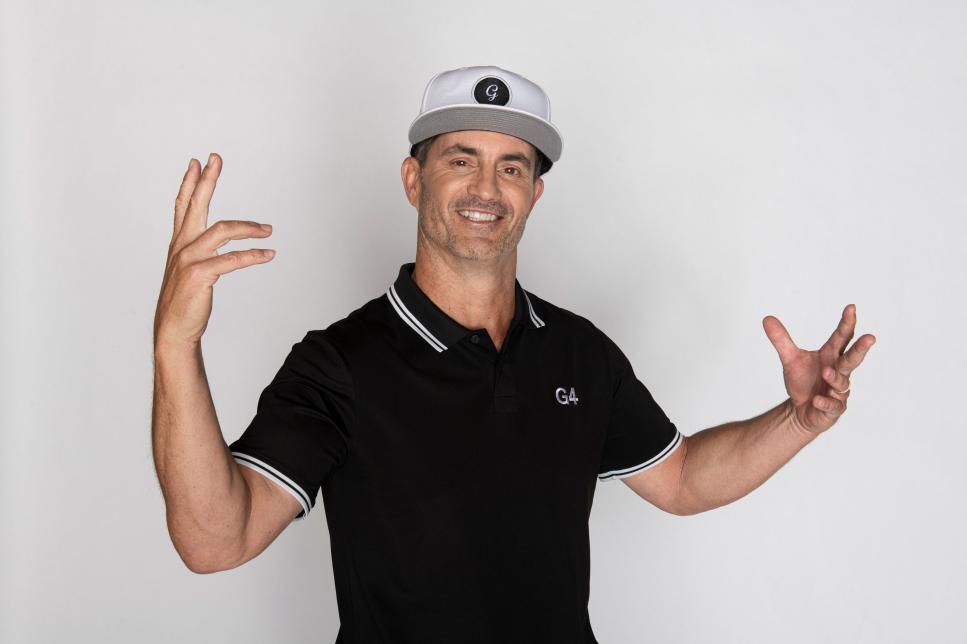
Dom Furore
No. 19: George Gankas
The world’s hottest golf instructor works out of a par-67 public course, gives his lessons on a mats-only range, wears flip flops while teaching, calls his students “scooshie” and has more than 184,000 Instagram followers. Does it get any more 2019? George Gankas’ gospel of speed has long attracted a host of up-and-comers to Westlake Golf Course’s driving range near Los Angeles. (One of those up-and-comers, once upon a time, was this writer.) Another, more promising one was Matthew Wolff, who had come to Gankas with an unorthodox loop in his backswing. Other teachers wanted to “fix” it; Gankas fell in love with it. As Wolff catapulted to stardom this summer, his swing—and the guy who molded it—became the talk of golf. The success of two of Gankas’ other students, Sung Kang, who became a first-time PGA Tour winner in May at the AT&T Byron Nelson, and Akshay Bhatia, who became the first high schooler to make a U.S. Walker Cup team in September, only further contributed to Gankas mania. Think of the prototypical golf lesson. Now flush that image out of your head, because a session with Gankas is nothing like that. He’s 48, but acts half his age. Within 10 minutes you’ll have an alignment stick in your belt, a block between your arms, and George will be talking about boxers. He is the quintessential modern teacher, and he’s also singlehandedly responsible for “Gucci” entering the golf lexicon. Golf is a smarter, younger and funner place with him in it. —Daniel Rapaport

Gregory Shamus
No. 20: Michelle Wie
As has been the case for most of Michelle Wie’s professional career, 2019 was a year of striking highs and lows. After surgery the previous October to repair an injured right wrist, which had sidelined her for the second half of 2018, Wie was hopeful she’d return pain free. That optimism dimmed, though, shortly into the new season. After just four starts, she took two months off to rest the wrist again. Wie appeared next at the KPMG Women’s PGA Championship in June, eager to play, but still not healthy. She toughed out an opening 12-over 84 at Hazeltine National, then she greeted the media initially with smiles and affirmations, until her tone changed. “It’s just one of those situations where I’m not, you know, I’m not entirely sure how much more I have left in me, so even on the bad days I’m just trying to take time to enjoy it,” Wie said, tearing up and retreating from the camera. It was an admission of how much pain she was in, her body telling her that there is a breaking point—an unsettling realization for any athlete. She shot an 82 in the next round, and a week later announced she’d be taking the rest of the season off. So where are the highs, you ask? They came later and off the course. In August, Wie married Jonnie West, son of NBA legend Jerry West who works in the Golden State Warriors’ front office. In September, she appeared as a guest studio analyst for the Golf Channel during its coverage of the Solheim Cup, and received solid reviews. Though Wie, who turned 30 in October, hasn’t offered any public hints about when she might compete again, she will continue her TV work. CBS Sports announced this month that Wie would contribute to its multimedia golf coverage in 2020, including at the Masters. —Keely Levins

Streeter Lecka
No. 21: New FedEx Cup format
It’s not entirely clear what iteration we’re on at this point, the PGA Tour brass having done much tinkering with the FedEx Cup Playoffs over its 13-year history. But there’s reason to believe this latest version of the season finale is here for at least a little while. The simplified format at the Tour Championship achieved its main goal, providing clarity in who was the one true winner on the 72nd green at East Lake. Congrats to Rory McIlroy, your 2019 FedEx Cup champion. Job well done. The fact he was fending off Brooks Koepka, the World No. 1 and FedEx Cup leader most of the season, for the whole shebang on the final day was also compelling … until it wasn’t, McIlroy dialing down the drama as he dialed up his play, shooting a final-round 66 to stroll off with a four-shot win. For its potential merits, the new format—with the 30 players beginning the tournament in a staggered start based on where they ranked on the FedEx Cup points list upon arriving in Atlanta and the Tour Championship winner automatically crowned FedEx Cup champ—will take some getting used to. Justin Thomas, the leader at 10 under prior to hitting his opening tee shot, talked about being unsettled with how to play from out front before the tournament had even begun. It took a round before the confusing feeling lifted. Indeed, there was always going to bit of uncertainty baked in for Year 1 of the new format. How that settles out in Years 2, 3 and 4, will determine whether the golf world can truly accept it moving forward. —Christopher Powers

No. 22: Bio Kim
Bio Kim won the DGB Financial Group Volvik Daegu Gyeongbuk Open in September, his second title of the year on the Korean Tour. But that fact was quickly forgotten when the Korean Professional Golfers Association hit the tour’s leading money winner with a three-year suspension afterward for an incident that occurred during the final round. Holding a one-stroke lead on the 16th hole, the 29-year-old lost his cool after hearing a cellphone camera shutter during his downswing. Kim turned to where he heard the noise and flipped off the crowd, then slammed his club into the turf. Video of the obscene gesture went viral, and the lengthy suspension sparked a worldwide discussion regarding what’s an acceptable punishment when a golfer—or any athlete—responds to fans with vitriol. Part of the explanation for the harsh sentence was that such gestures have a far greater stigma in Korean culture than in the western world, explaining, too, why Kim responded by kneeling in front of television cameras to apologize and saying he wouldn’t appeal the decision. Within the golf community, a number of players spoke out in support of Kim, who played on the PGA Tour in 2011. “You’re taking a man’s job for three years,” said Kevin Na, Kim’s loudest advocate. “Yes, he was unprofessional and there should be consequences for it, but don’t take a man’s job away for three years.” A few weeks later, the KPGA relented and reduced the suspension to a year. Kim was still fined more than $8,300 and ordered to complete 120 hours of community service—and the debate continued as to whether that was still too severe. —Brian Wacker

Kevin C. Cox/Getty Images
No. 23: Jordan Spieth’s weekend woes
In one important way, things returned to normal for Jordan Spieth in 2019 as he finished second in strokes gained/putting after being a dismal 123rd the previous year. But for a disappointing second straight season, there were no first-place finishes on Sunday for the young star thanks in large part to a troubling trend. As consistently as the three-time major champ played fantastic golf on weekdays—he ranked ninth in first-round scoring and first on Fridays—he tumbled down leader boards just as often on the weekends with dismal rankings of 170th and 187th in the third and fourth rounds, respectively. “Historically, I'm a very consistent player,” Spieth said at the Northern Trust in August, where he was one shot off the 36-hole lead, but finished T-6. “I've lost a bit of that. I still have the firepower, but that consistency is what I'm trying to get back.” That will take a major improvement in strokes gained/off-the-tee (176th) and strokes gained/approach (145th). Fortunately for Spieth, 26, he still has a lot of time to figure things out. And that putter. —Alex Myers

Cy Cyr
No. 24: Kyle Berkshire
With all due respect to John Daly, the “grip it and rip it” movement has a new leader. Kyle Berkshire, a 6-foot-3, 215-pound former college golfer from Crofton, Md., sports longer hair than JD did in his peak mullet days. He also bombs the golf ball distances the longest PGA Tour pros don’t dream of. “If I’m hitting the ball on the center of the face, if I’m optimizing my speed … I’m going to win,” Berkshire said ahead of September’s World Long Drive Championship. “That’s just the way it is.” The 22-year-old was right, although he made things dramatic by needing to find the grid with his eighth and final swing to advance in the Round of 16 and dodging a rules controversy (Yes, these pop up even in long-drive contests). His winning drive went 406 yards, giving Berkshire his third victory on the long-drive circuit in 2019 and making it five times in six starts that he finished first or second. Berkshire credits his North Texas golf coach, Brad Stracke, for suggesting he give long drive a try during his sophomore year when he was recording eye-popping ball speeds off his clubface (he set a long-drive record this year, hitting one 228 mph). Originally, Berkshire hoped it would give him confidence to help his overall golf game. But while he certainly gained that confidence, he wound up finding a new career pursuit altogether. Long live long drive’s new king.—Alex Myers
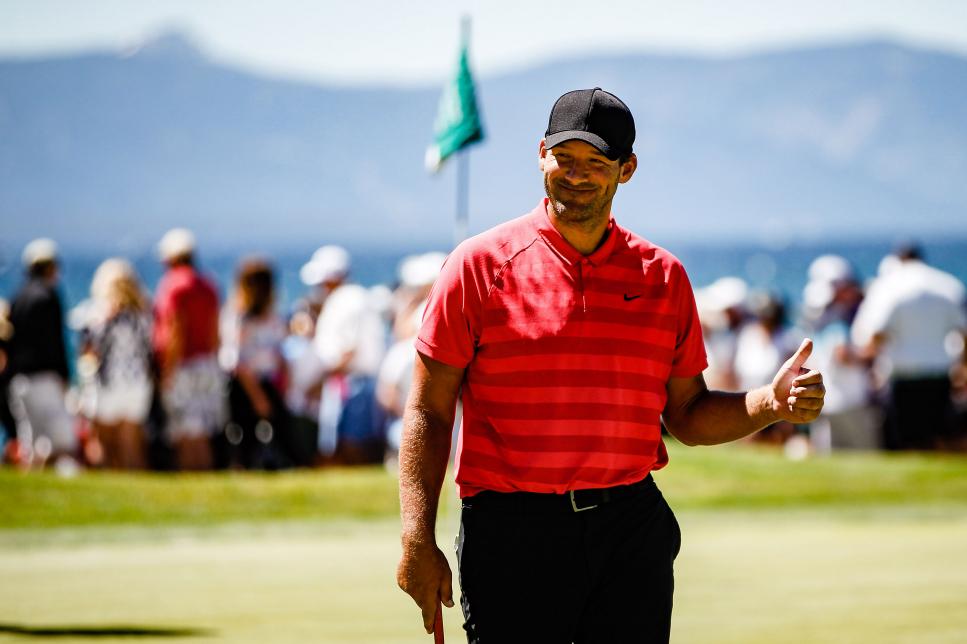
Jonathan Devich/Getty Images
No. 25: Tony Romo
He didn’t become the 50,000-to-1 long-shot winner of the Safeway Open that the Westgate Las Vegas Superbook projected, but Tony Romo had a two-under-par 70 in the first round in Napa, Calif., that surprised prognosticators and fans alike—and changed public perceptions. The former Dallas Cowboys quarterback took over the golf world for 24 hours just as he had on the gridiron every Sunday for a decade. Over the past few years, the 39-year-old has cemented himself as an amateur golf professional—playing four times in PGA Tour events on sponsor’s exemptions. It wasn’t until Safeway in September, though, that he truly turned heads as a golfer. When Romo signed his scorecard that Thursday, he was tied for 20th, only five shots behind early leader Adam Scott. He even took down his two playing partners, Beau Hossler and Michael Gellerman. Yes, a Friday 78 kept him from getting the chance to play two more rounds. Still, just as some were wondering how long the sponsor’s exemptions might continue, Romo showed maybe he actually did deserve them. We’re not going to be adding him to our “Golfers that will define 2020” list, but it might behoove CBS to continue to have a backup plan for broadcasting teams just in case Romo makes a weekend cut next year. —Greg Gottfried